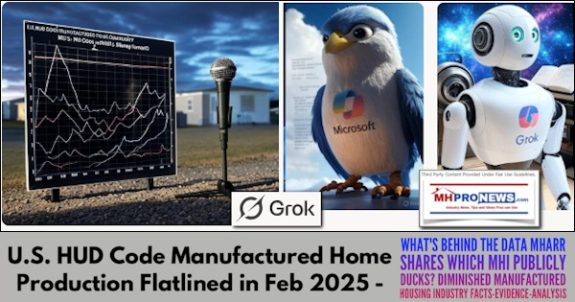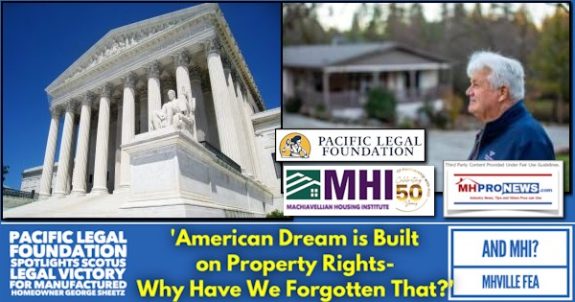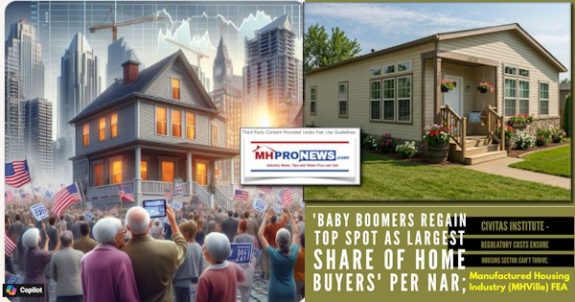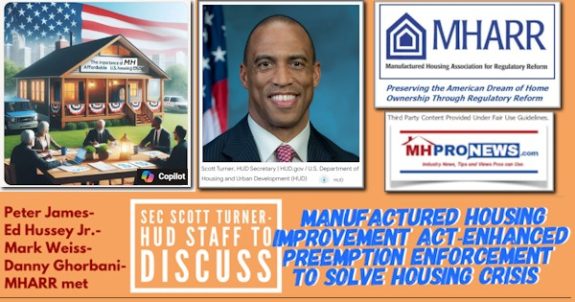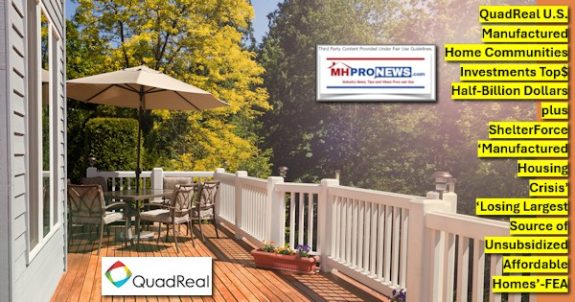
CFPB and Dodd-Frank Regulatory Update
On January 10th, the Consumer Financial Protection Bureau (CFPB or the Bureau) unveiled the first round of final mortgage finance rules required under the Dodd-Frank Act. These rules govern a variety of mortgage activities of key concern to the manufactured housing industry. Over the coming days,MHI will release summaries of these rules for members to use as a reference guide.
Qualified Mortgage/Ability-to-Repay Guidelines
The final rule, as required under the Dodd-Frank Act, requires that no lender make a residential mortgage without documenting a borrower’s ability to repay the loan. A creditor may presume it has met this requirement if the originated loan meets the criteria of a Qualified Mortgage (QM). The rule is effective January 10, 2014. MHI members can visit www.manufacturedhousing.org/Finance/ to view a summary of the rule.
There are several guidelines of particular concern to MHI members.
1. Two-tier legal standard for QMs: The CFPB conveys two different standards of legal protection (safe harbor vs. rebuttable presumption) to QMs, which is based solely upon the annual percentage rate (APR) of the loan. QMs that offer “prime” interest rates will have “safe harbor” status. However, QMs that are considered Higher-Priced Mortgage Loans (HPMLs)—first lien mortgages with an APR of 1.5 percent or more over the average prime offer rate (APOR)—will be provided “rebuttable presumption” status.
2. Limitations on QM points and fees: the Dodd-Frank Act generally limits the points and fees payable in connection with a QM to three percent of the loan amount.
a.) However, the Act required the CFPB to exceed this threshold for smaller-sized loans. In its 2011 proposed rule, the CFPB considered two draft alternatives for fulfilling this requirement that would have applied to loans $75,000 or less: 1) a sliding fee scale; and 2) a formula-based mechanism. Both measures limited the lender’s ability to fully recoup the costs associated with loan origination.
In multiple meetings with the CFPB, including a meeting with Director Richard Cordray, MHI raised this concern and emphasized the need for manufactured home lenders to cover their fixed origination costs. While the final rule falls short of MHI’s recommendation, the Bureau did expand upon its initial proposal. Under the rule, a transaction is a QM provided the total points and fees payable in connection with the loan do not exceed:
• For a loan amount greater than or equal to $100,000, three percent of the total loan amount;
• For a loan amount greater than or equal to $60,000 but less than $100,000, $3,000;
• For a loan amount greater than or equal to $20,000 but less than $60,000, five percent of the total loan amount;
• For a loan amount greater than or equal to $12,500 but less than $20,000, $1,000; and
• For a loan amount less than $12,500, eight percent of the loan amount.
• Note: the loan amounts are all indexed to inflation.
3. Small Creditor QM exemption proposal: In response to concerns raised by small-sized lenders, including those servicing the manufactured housing industry, the CFPB has proposed the establishment of an additional QM class. Under the proposal, “smaller creditors” would be able to originate loans up to 3.5 percent over APOR and still receive “safe harbor” status. In addition, “smaller creditor” would be able to originate loans that exceed the maximum 43 percent debt-to-income (DTI) ratio established for QMs provided the loan still met the other QM criteria. A “small creditor” would be considered one that: 1) has total assets of $2 billion or less at the end of the previous calendar year; and 2) together with all affiliates, originated 500 or fewer first-lien covered transactions during the previous calendar year. In addition, the new QM category would only include loans held in portfolio by these creditors. The CFPB is seeking comment on this proposal. Comments are due February 25, 2013.
This proposal is of significant interest to MHI members and the manufactured housing industry in that this provision would cover small community banks and credit unions as well as non-bank manufactured home lenders, including manufactured housing community owners that originated manufactured home loans.
Click here to view the complete QM rule, and concurrent proposed rule, located on the CFPB website.
High-Cost Mortgage Regulations
Under the final rule (as outlined in Dodd-Frank), a mortgage is considered “high-cost” if it exceeds specific APR and/or points and fees triggers. Specifically:
• APR triggers: a mortgage is “high-cost” if the APR of the loan is more than 6.5 percent over APOR,
• APR triggers for personal property transactions: if the home being financed is considered personal property and the loan is less than $50,000 then it is considered “high-cost” if the APR exceeds the APOR by more than 8.5 percent, and
• Points and Fees triggers:
– For loans $20,000 and greater: a loan is considered “high-cost” if points and fees exceed five percent of the loan amount, and
– For loans less than $20,000: a loan is considered “high-cost” if the points and fees exceed the lesser of eight percent or $1,000.
If the loan is considered “high-cost” then there are a number of restrictions on the loan, including:
• Balloon payments are generally prohibited,
• Prohibition on pre-payment penalties (also prohibited if the loan is an HPML),
• Late-fees restricted to four percent of the past due payment,
• Before originating a “high-cost” mortgage, the creditor must verify that the consumer has received counseling from a federally-approved homeownership counselor, and
• The creditor (and any assignee) must assume liability for enhanced damages under TILA.
Under the changes outlined in Dodd-Frank, all purchase loans (including mortgages on manufactured homes considered personal property) are now covered by the HOEPA limits. The rules become effective January 10, 2014. Loans not covered by HOEPA, include construction loans, loans from a Housing Finance Authority, USDA Section 502 loans, and reverse mortgages.
Finally, the CFPB decided not to include in the final HOEPA rule an “all-in APR” finance-charge option that would have dramatically altered APR calculations.
MHI will be developing a more comprehensive summary of the HOEPA final rule for distribution to MHI members in the coming days. To view the full rule,click here.
TILA Escrow Requirements
On January 10th, the CFPB also issued revised requirements (as outlined in the Dodd-Frank Act) dictating the establishment of escrow accounts for HPMLs as defined under the Truth in Lending Act (TILA; Reg. Z). The rule, which takes effect June 1, 2013, requires creditors originating an HPML to maintain an escrow account for five years. The current requirement is one year.
The rule also creates an exception, as required under Dodd-Frank, from the escrow requirements for small creditors that operate predominantly in rural or underserved markets. To be eligible for the exemption, a creditor must: 1) make more than half of its mortgages in rural or underserved areas (to be specified by the CFPB); 2) have assets of less than $2 billion; 3) originate 500 or less mortgages for the previous calendar year; and 4) generally doesn’t hold escrow accounts for any of its current mortgage customers.
To view the final rule, click here.
Appraisals for Higher-Risk Mortgages
On January 18th, the CFPB released final rules requiring that an appraisal—including an interior inspection of the home— be conducted for mortgages considered “higher-risk.” A higher-risk mortgage is essentially an HPML. However, the rule, as well as the Dodd-Frank Act, granted a number of exemptions from this requirement. The final rule goes into effect January 18, 2014.
The Dodd-Frank Act specifically exempts qualified mortgages and certain reverse mortgages from these rules. In addition to exempting these loans, the rule also exempts:
• All reverse mortgages,
• Loans for initial construction of a dwelling,
• Temporary bridge loans (for 12 months or less),
• Loans secured by a new manufactured homes, and
• Transactions secured by a mobile home, boat, or trailer.
The proposed rule had initially sought to exempt all home-only (personal property) transactions from the appraisal requirement. The final rule modified this exemption to include:
• All new manufactured homes regardless of whether the structure is attached to land or considered real property, and
• All mobile homes even if the transaction is also secured by land (it is critical to note the for the final rule “mobile” is defined to mean non-HUD Code or Pre-1976 mobile homes).
The CFPB will release a supplemental proposal in the coming days regarding the expansion of this exemption to existing manufactured homes and MHI will provide additional details of the expanded proposal once it becomes available.
MHI has strongly urged the CFPB to exempt manufactured homes from the appraisal guidelines, regardless of whether the structure was considered personal or real property. The final rule builds on MHI’s work in this area.
MHI will distribute a summary of the appraisal rule to members. Click here to view the complete rule.
RESPA & TILA Mortgage Servicing Guidelines
On January 17th, the CFPB issued its final rules outlining servicing guidelines for mortgages under TILA and the Real Estate Settlement Procedures Act (RESPA; Reg. X). The rules go into effect January 10, 2014.
Of interest to the manufactured housing industry, particularly smaller sized lenders that service loans they originate including manufactured home community owners, is that the final rules include a number of exemptions for “small servicers.” Small servicers are defined as servicers that service 5,000 or fewer mortgage loans and service only mortgage loans that they or an affiliate originated or own.
In its comments, MHI urged the CFPB to adopt the broadest level of exemptions possible for small-sized manufactured home lenders which are often comprised of manufactured home community owners financing the sale of homes they own.
In the final rules, small servicers are exempted from a number of the RESPA and TILA servicing guidelines, including requirements for:
• Periodic billing statements,
• Force-placed insurance,
• Early intervention with delinquent borrowers,
• Continuity of contact with delinquent borrowers,
• Loss mitigation procedures, and
• Document retention.
MHI will develop a more complete summary of the servicing requirements for members in the coming days. Click here to view the complete rule.
Federal Regulations Planned for 2013 Will Impact Manufactured Housing
On January 7, 2013, the Federal Government’s Semi-Annual Regulatory Agenda (SAR) was published in the Federal Register. Below are planned regulatory actions of significant interest to the manufactured housing industry and the anticipated date of publication.
Department of Housing and Urban Development (HUD)
May 2013 – Final rule to revise the notification, correction and procedural regulations of Subpart I of the Manufactured Home Procedural and Enforcement Regulations (24 CFR Part 3282).
June 2013 – A final rule for on-site completion of construction of manufactured homes.
June 2013 – A final rule to revise and update the Manufactured Home Construction and Safety Standards.
Department of Energy (DOE)
There is nothing in the SAR regarding proposed rulemaking for energy efficiency standards for manufactured housing because the draft rule which has been completed by DOE is pending for publication at the Office of Management and Budget (OMB).
Environmental Protection Agency (EPA)
January 2013 – A proposed rule to establish specific national formaldehyde emission limits for hardwood plywood, particleboard, and medium-density fiberboard that are identical to the California emission limits for the same products is pending for publication at the OMB.
Consumer Financial Protection Bureau (CFPB)
Various rules either issued or planned to be issued by the CFPB are detailed in the above Dodd-Frank/CFPB update written by Jason Boehlert.
Occupational Standards Health and Safety Administration (OSHA)
October 2013 – OSHA plans to hold panel discussions with small businesses to obtain input on its efforts to establish standards for combustible dust hazards.
“Proud Member of MHI” Logo Available for Members
A new “Proud Member of MHI” logo is now available for MHI members. We encourage all MHI members to actively use the logo in marketing materials, websites, and on display in their business locations. Members do business with members. This is a great way to show your pride and support as an MHImember. Download the logos atwww.manufacturedhousing.org/about_us/default.asp.
Be Sure to Stop By the MHI Booth
MHI will be exhibiting at the upcoming 2013 Louisville Manufactured Housing Show from January 23-25, 2013. Click here to visit the website. This significant annual event is sponsored by the Midwest Manufactured Housing Federation and is produced by Show Ways Unlimited. Because we are an exhibitor at the show, MHI received notice that the show’s website has had over 130,000 hits through December and that pre-registrations are up by over 121 for the same time frame in 2012. Show projections suggest this year may have as many as 1,700 attendees. We are located in Booth #301 and look forward to seeing and meeting with you.





















